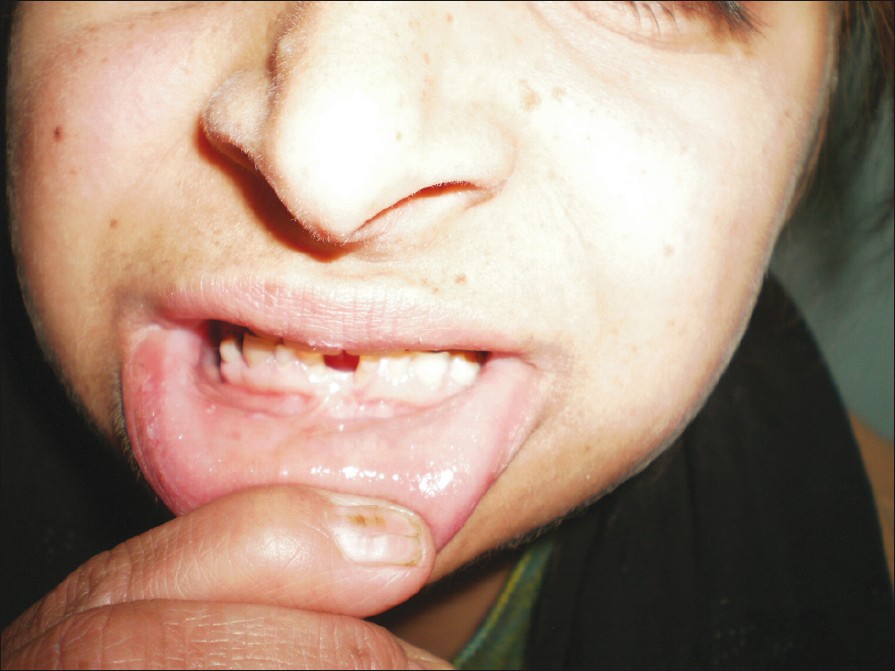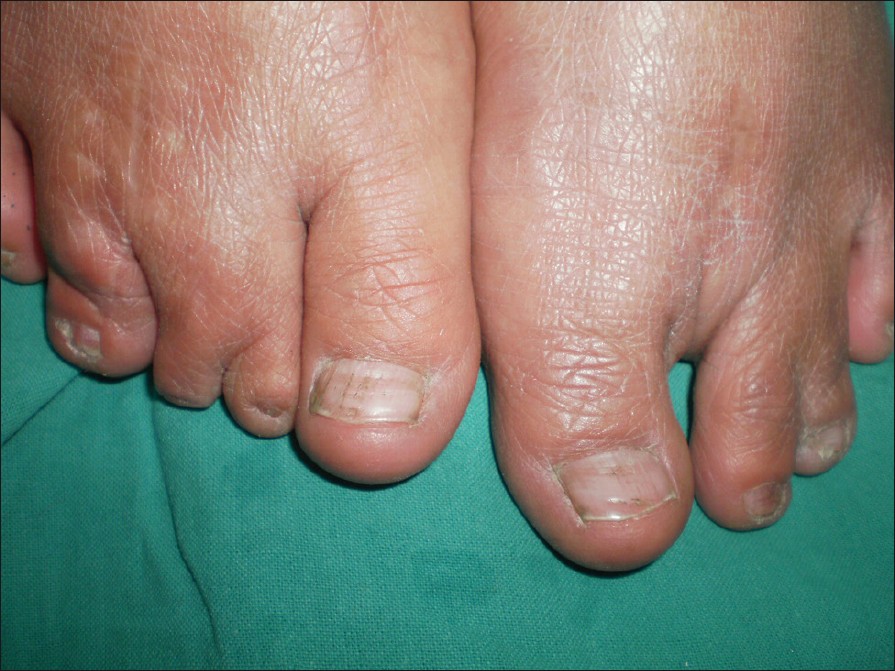Translate this page into:
Ectodermal dysplasia with syndactyly
Correspondence Address:
Iffat Hassan
1 House No: 35, Mominabad Hyderpora, Srinagar, Jammu and Kashmir 190 014
India
| How to cite this article: Keen A, Hassan I. Ectodermal dysplasia with syndactyly. Indian J Dermatol Venereol Leprol 2012;78:387-389 |
Sir,
Ectodermal dysplasias are genetically heterogenous and complex group of inherited disorders characterized by structural and/or functional defects in one or more of the classical ectodermal appendages (hairs, nails, teeth, sweat glands) during morphogenesis or development. [1] These disorders are clinically divided into hidrotic and anhidrotic forms and each of these forms is further subdivided into various syndromes. Ectodermal dysplasia with syndactyly is a rare clinical entity. We present a patient of ectodermal dysplasia with syndactyly in view of the clinical rarity of this condition.
A 20-year-old female, born at term of a first degree consanguineous marriage presented with a history of delayed dentition and repeated dental caries. Her parents reported that her temporary teeth were abnormal in number and shape and were lost early. She had abnormal permanent teeth and had to use dentures in place of her lost teeth from the age of 15 years. She also gave a history of sparse and brittle hair as well as abnormal nails since childhood. Her developmental milestones were normal as per her age. There was no history of recurrent or high grade fever, recurrent upper or lower respiratory tract infections and convulsions during infancy. There were no such cases known in the family till date. There was no history of hypohidrosis, hypotrichosis or dental abnormalities in the family. She had a normal intelligence and was a college student.
Examination of the patient revealed dental abnormalities including malformed teeth, hypodontia, oligodontia, dental caries [Figure - 1], upper fixed denture and high arched palate. Cutaneous examination revealed hair abnormalities including sparse and lustreless scalp hair. Eyebrows and eyelash were also sparse. However, pili torti (twisted hair) was not observed. Examination of nails showed ridging and yellowish discoloration of nails more marked on fingernails than toenails. She also had syndactyly involving her second and third toes of both feet [Figure - 2]. Systemic examination revealed no abnormality. Neurological examination as well as ophthalmological examination revealed no abnormality, and her speech was also normal. Examination of the parents and siblings was normal and revealed no abnormality of hair, nails or teeth. Starch iodine test was done which was positive demonstrating normal sweat gland function. Radiography of the bones and joints revealed no evidence of any bony lesion. Chest X-ray as well as ultrasonography of abdomen were both normal. Skin biopsy was not done as the patient was quite reluctant for the procedure. In view of the constellation of clinical features, a diagnosis of ectodermal dysplasia with syndactyly was considered.
 |
| Figure 1: Showing hypodontia, oligodontia and carious teeth |
 |
| Figure 2: Showing syndactyly involving toes of both feet along with nail changes |
Ectodermal dysplasias constitute a complex group of disorders characterized by various defects in hair, nails, teeth and sweat glands. Several classifications exist for this disorder. Friere - Maia and Pinheiro have proposed a classification based on the involved ectodermal derivatives. [1] There are more than 10 subgroups in this classification. Anhidrotic (hypohidrotic) ectodermal dysplasia is the most common type of ectodermal dysplasia (80%). Ectodermal dysplasias (ED′s) may be pure ED′s involving only classical ectodermal appendages or syndromic ED′s affecting other organs and organ systems. The number of ectodermal dysplasia syndromes has increased to more than 170 syndromes. [2] Syndromic forms of ectodermal dysplasias are mostly associated with deafness, skeletal defects, mental retardation, icthyosis, palmoplantar keratoderma, ocular abnormalities, cleft lips and palate, and other systemic conditions. [3] Few syndromic forms of ectodermal dysplasias have been characterized at the molecular level. Still large numbers have been reported, which are awaiting their molecular diagnosis.
Several types of ectodermal dysplasias associated with syndactyly have been reported in literature. [4],[5] Ectodermal dysplasia with syndactyly is a rare ED entity. This syndrome has an autosomal recessive mode of inheritance. Recently, sequence analysis has revealed that a homozygous missence mutation in the PVRL 4 gene may have a role in the development of this distinct entity. [6]
This syndrome is clinically characterized by hypotrichosis with brittle scalp hair, pili torti especially of the eyebrows and eyelashes. Dental abnormalities may present as hypodontia or anodontia, delayed and atypical eruption of permanent teeth. Nails are yellowish and partially thickened. There may also be a transverse crease on both the palms. The sweat glands may be normal in function. The ocular manifestations include mild crowding of the lenses and a discrete hypermetropia. Syndactyly may be present in fingers and toes to variable degrees. Other phenotypic characteristics include a highly arched palate and lordosis.
Our patient had ectodermal dysplasia with syndactyly and high arched palate. There were no ocular features or transverse palmar crease in our patient.
| 1. |
Pinheiro M, Freire-Maia N. Ectodermal dysplasias: A clinical classification and a casual review. Am J Med Genet 1994;53:153-62.
[Google Scholar]
|
| 2. |
Lamatine J. Towards a new classification of ectodermal dysplasias. Clin Exp Dermatol 2003;28:351-5.
[Google Scholar]
|
| 3. |
Itin PH, Fistarol SK. Ectodermal dysplasias. Am J Med Genet 2004;131C:45-51.
[Google Scholar]
|
| 4. |
Boudghene-Stambouli O, Merad-Boudi A. Association of ectodermal dysplasia and syndactyly. Ann Dermatol Venereol 1991;118:107-10.
[Google Scholar]
|
| 5. |
Gillespie FD. Hereditary syndrome: Dysplasia oculodentodigitalis. Arch Ophthalmol 1964;71:187-92.
[Google Scholar]
|
| 6. |
Jelani M, Chishti MS, Ahmad W. Mutation in PVRL4 gene encoding nectin-4 underlies ectodermal-dysplasia-syndactyly syndrome (EDSS1). J Hum Genet 2011;56:352-7.
[Google Scholar]
|
Fulltext Views
3,255
PDF downloads
2,282





